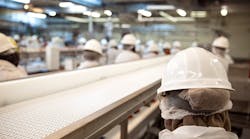As industries go, food has been in a relatively good position during the coronacrisis.
Food processors provide something that people literally can’t live without. They have been universally exempted from bans on people gathering together, and in the case of the meat industry, have been mandated to stay open by presidential executive order. For these reasons, the industry for the most part has been able to keep its workers gainfully employed, turning out products that consumers, hunkering down at home whenever possible, need more than ever.
And, as hideous, contagious and destructive as COVID-19 is, at least it’s not a foodborne illness. It doesn’t pose the dangers of, say, listeriosis or E. coli infections, or tuberculosis in a bygone era – silent killers that can spread from food plants to sicken and kill consumers by the hundreds, or the thousands.
The danger of coronavirus is in person-to-person transmission, which is why “social distancing” is now all the rage. (Literally, in some cases. Have you seen the video of that Italian mayor screaming at some guy defying the stay-at-home order, “You are not the last person on Earth! You are not Will Smith in ‘I Am Legend’!”?)
Even in this respect, most food plants have a big advantage over other forms of manufacturing: Sanitation is built into their operations. Gloves, shoe coverings and, often, masks are standard gear; cleaning is systematic and periodic. The coronavirus, like almost all microorganisms, is vulnerable to standard cleaning chemicals.
But that doesn’t mean everything is rosy. Food plants have been hit by forced closings, especially in the meat and poultry sector, with more than 20 plants shutting down at least temporarily. Tragically, there have been more than 20 deaths from COVID-19, almost all occurring in meat and poultry.
The biggest problem is that in many food plants, “social distancing” is hard if not impossible to achieve. Many plants, especially meat and poultry processors, set workers up virtually shoulder-to-shoulder.
The danger is heightened by the fact that the coronavirus can live for up to 72 hours on stainless steel, which is the dominant surface material on almost all processing lines. Practically speaking, this means that potential danger exists until the next round of sanitation takes place – which, in many cases, means the end of the shift, if not the end of the workday.
Other aspects of the coronavirus make matters worse. Workers can be contagious for up to 14 days before they show symptoms – if they show them at all. That makes efforts at screening workers, for example by scanning their foreheads with temperature guns, more or less futile.
Plants that are able to institute separation have been doing so. Some companies are imposing isolation as far as possible, with teams of workers being instructed to stick with each other and not mingle with others. Some plants are closing down their break rooms and other common areas entirely; others are restricting their use through measures like staggering lunch breaks. Whenever possible, sanitation is being done at every opportunity, during every break in a cycle, not just at the end of a shift.
But no matter what is done to protect workers, there’s no way to avoid the bottom line: They’re being asked to risk their lives to feed the rest of us. And the strain is showing. At first it was the strain of having to work extra hours or shifts to meet demand; now it’s the strain of having to risk infection by working close to others.
A lot of companies are offering bonuses, either one-time or hourly, to show their appreciation for the workers who keep showing up despite the danger. But it’s becoming clear that that will no longer be enough. Paying workers a few dollars more an hour is not going to be a substitute for keeping them safe.
It’s questionable how much longer the industry’s workers are willing to take these conditions, mentally as well as physically. The processing plants that are best able to survive the coronacrisis will probably be the ones that are best able to keep workers separate.
That means different things in different locations. Plants that instituted automation will be in the best position: when one worker at a PLC replaces half a dozen on a line, that’s half a dozen people who aren’t standing shoulder to shoulder. Where close proximity is the norm, plants may have to consider slowing production to allow workers to spread out.
Over the long term, keeping workers safe and motivated is going to be tough, and a $2-an-hour raise is very likely not going to do it.


